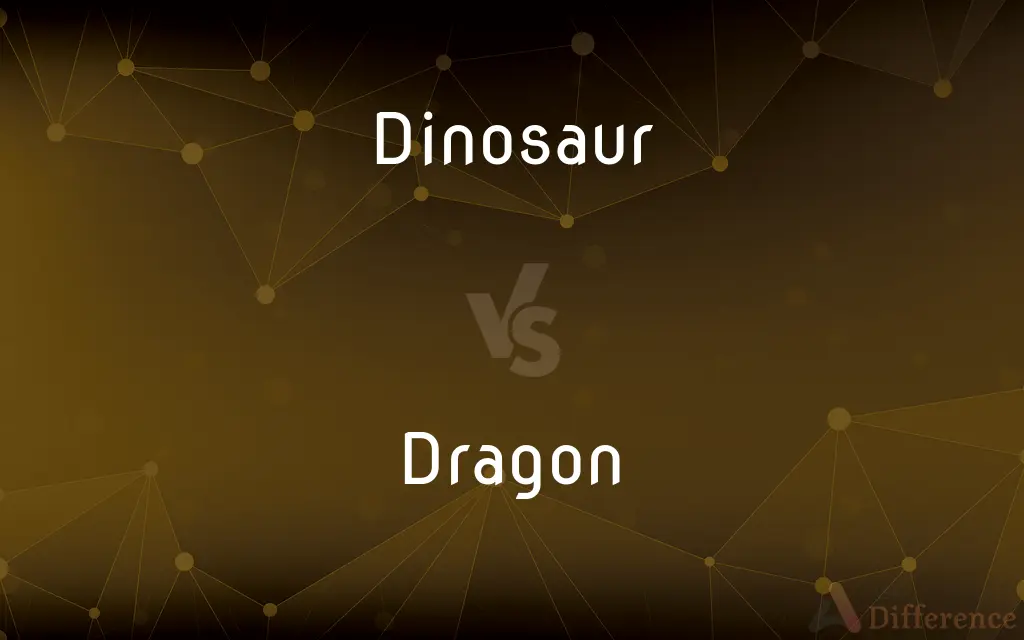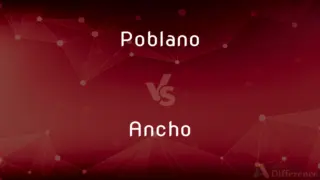Dinosaur vs. Dragon — What's the Difference?
By Tayyaba Rehman — Updated on November 6, 2023
Dinosaurs were real, prehistoric reptiles that lived millions of years ago. Dragons are mythical creatures featured in folklore and fantasy.

Difference Between Dinosaur and Dragon
Table of Contents
ADVERTISEMENT
Key Differences
Dinosaurs are a diverse group of reptiles of the clade Dinosauria that first appeared during the Mesozoic Era. They are known to have evolved into a variety of forms and sizes, from the fearsome T-Rex to the towering Brachiosaurus. Dinosaurs, as understood by paleontology, were real animals that roamed the Earth and left behind fossils as evidence of their existence.
Dragons, on the other hand, are legendary creatures that appear in the myths of many cultures around the world. Unlike dinosaurs, dragons are often depicted as fire-breathing and possessing magical qualities. They are a staple in fantasy literature and are symbolic rather than historical, with no evidence suggesting they ever lived.
Dinosaurs are often characterized by their distinct bone structures, such as the frills and horns of Triceratops or the plates and spikes of Stegosaurus. Their physical characteristics are derived from fossil records. Scientific research into dinosaurs focuses on their behaviors, evolution, and extinction at the end of the Cretaceous period.
Dragons are characterized more by their cultural significance than by any unifying physical characteristics. They can have varying numbers of heads, legs, and wings, depending on the culture from which the dragon myth originates. In many traditions, dragons are seen as powerful and sometimes malevolent beings; in others, they are benevolent or wise.
Comparison Chart
Nature
Real, prehistoric animals
Mythical, legendary creatures
ADVERTISEMENT
Evidence
Fossils
Mythological texts and folklore
Physiology
Non-avian dinosaurs were non-flighted
Often depicted with wings and flight
Temporal Existence
Existed millions of years ago
Timeless, exist in myths across eras
Cultural Representation
Subject of scientific study
Symbolic, featuring in stories and art
Compare with Definitions
Dinosaur
Extinct reptile of the Mesozoic era
The dinosaur's fossil was displayed at the museum.
Dragon
Mythical beast often depicted as fire-breathing
The dragon guarded the castle in the story.
Dinosaur
Member of the Dinosauria clade
Dinosaurs once dominated the terrestrial ecosystem.
Dragon
A dragon is a large, serpentine, legendary creature that appears in the folklore of many cultures worldwide. Beliefs about dragons vary considerably through regions, but dragons in western cultures since the High Middle Ages have often been depicted as winged, horned, four-legged, and capable of breathing fire.
Dinosaur
A term used metaphorically for something outdated
His flip phone is a dinosaur.
Dragon
See Draco2.
Dinosaur
A general term for non-avian dinosaurs
Kids are often fascinated by dinosaur bones.
Dragon
A mythical monster traditionally represented as a gigantic reptile having a long tail, sharp claws, scaly skin, and often wings.
Dinosaur
Dinosaurs are a diverse group of reptiles of the clade Dinosauria. They first appeared during the Triassic period, between 243 and 233.23 million years ago, although the exact origin and timing of the evolution of dinosaurs is the subject of active research.
Dragon
Any of various lizards, such as the Komodo dragon or the flying lizard.
Dinosaur
Any of various extinct terrestrial reptiles of the orders Saurischia and Ornithischia that existed during the Mesozoic Era, including both carnivores and herbivores and often reaching a gigantic size.
Dragon
A fiercely vigilant or intractable person.
Dinosaur
Any of various other large extinct reptiles, such as an ichthyosaur.
Dragon
Something very formidable or dangerous.
Dinosaur
A relic of the past
"living dinosaurs of the world of vegetation" (John Olmsted).
Dragon
(Archaic) A large snake or serpent.
Dinosaur
One that is hopelessly outmoded or unwieldy
"The old, big-city teaching hospital is a dinosaur" (Peggy Breault).
Dragon
A legendary serpentine or reptilian creature.
Dinosaur
(scientific) any of the animals belonging to the clade Dinosauria, especially those that existed during the Triassic, Jurassic and Cretaceous periods and are now extinct.
Dragon
In Western mythology, a gigantic beast, typically reptilian with leathery bat-like wings, lion-like claws, scaly skin and a serpent-like body, often a monster with fiery breath.
Dinosaur
(colloquial) any member of the clade Dinosauria other than birds.
Dragon
In Eastern mythology, a large, snake-like monster with the eyes of a hare, the horns of a stag and the claws of a tiger, usually beneficent.
Dinosaur
(proscribed) Any extinct reptile, not necessarily belonging to Dinosauria, that existed between about 230 million and 65 million years ago.
Dragon
An animal of various species that resemble a dragon in appearance:
Dinosaur
Something or someone that is very old or old-fashioned, or is not willing to change and adapt.
Dragon
(obsolete) A very large snake; a python.
Dinosaur
Anything no longer in common use or practice.
Dragon
Any of various agamid lizards of the genera Draco, Physignathus or Pogona.
Dinosaur
One of the Dinosauria.
Dragon
A Komodo dragon.
Dinosaur
Any of numerous extinct terrestrial reptiles of the Mesozoic era
Dragon
The constellation Draco.
Dinosaur
Prehistoric creature studied by paleontologists
A new species of dinosaur has been discovered.
Dragon
(pejorative) A fierce and unpleasant woman; a harridan.
She’s a bit of a dragon.
Dragon
The (historical) Chinese empire or the People's Republic of China.
Napoleon already warned of the awakening of the Dragon.
Dragon
(figuratively) Something very formidable or dangerous.
Dragon
A type of playing-tile (red dragon, green dragon, white dragon) in the game of mahjong.
Dragon
A luminous exhalation from marshy ground, seeming to move through the air like a winged serpent.
Dragon
A short musket hooked to a swivel attached to a soldier's belt; so called from a representation of a dragon's head at the muzzle.
Dragon
A background process similar to a daemon.
Dragon
A variety of carrier pigeon.
Dragon
(slang) A transvestite man, or more broadly a male-to-female transgender person.
Dragon
A fabulous animal, generally represented as a monstrous winged serpent or lizard, with a crested head and enormous claws, and regarded as very powerful and ferocious.
The dragons which appear in early paintings and sculptures are invariably representations of a winged crocodile.
Thou breakest the heads of the dragons in the waters.
Thou shalt tread upon the lion and adder; the young lion and the dragon shalt thou trample under feet.
He laid hold on the dragon, that old serpent, which is the Devil and Satan, and bound him a thousand years.
Dragon
A fierce, violent person, esp. a woman.
Dragon
A constellation of the northern hemisphere figured as a dragon; Draco.
Dragon
A luminous exhalation from marshy grounds, seeming to move through the air as a winged serpent.
Dragon
A short musket hooked to a swivel attached to a soldier's belt; - so called from a representation of a dragon's head at the muzzle.
Dragon
A small arboreal lizard of the genus Draco, of several species, found in the East Indies and Southern Asia. Five or six of the hind ribs, on each side, are prolonged and covered with weblike skin, forming a sort of wing. These prolongations aid them in making long leaps from tree to tree. Called also flying lizard.
Dragon
A variety of carrier pigeon.
Dragon
A fabulous winged creature, sometimes borne as a charge in a coat of arms.
Dragon
A creature of Teutonic mythology; usually represented as breathing fire and having a reptilian body and sometimes wings
Dragon
A fiercely vigilant and unpleasant woman
Dragon
A faint constellation twisting around the north celestial pole and lying between Ursa Major and Cepheus
Dragon
Any of several small tropical Asian lizards capable of gliding by spreading winglike membranes on each side of the body
Dragon
A symbol of power and strength in Asian cultures
The dragon is revered during the Chinese New Year.
Dragon
Legendary creature in fantasy literature
Dragons are central to many high fantasy novels.
Dragon
An emblem or figure in heraldry
The family's coat of arms featured a red dragon.
Dragon
A metaphor for a formidable person
The CEO was known as the dragon of the industry.
Common Curiosities
Can dinosaurs fly?
Some dinosaurs, like certain theropods, evolved into birds, which can fly.
Were dinosaurs real?
Yes, dinosaurs were real creatures that existed millions of years ago.
Are dragons always evil in myths?
No, dragons are depicted as both evil and good in various cultures.
Did dinosaurs breathe fire?
No, there is no scientific evidence that dinosaurs could breathe fire.
Are dragon fossils real?
No, dragon fossils are not real as dragons are mythical.
What caused the extinction of dinosaurs?
The prevailing theory is that a massive asteroid impact caused their extinction.
Which cultures feature dragons in their folklore?
Many cultures, including Chinese, European, and Middle Eastern, have dragon myths.
Can dinosaurs be brought back to life?
Currently, it is not possible to bring dinosaurs back to life.
Are dragons dinosaurs?
No, dragons are mythical and not related to dinosaurs, which were actual animals.
Do dragons represent the same thing in all cultures?
No, dragons have different meanings in different cultures.
Do dragons exist?
Dragons are mythical creatures and do not exist in reality.
Did all dinosaurs go extinct?
All non-avian dinosaurs went extinct, but birds are considered their descendants.
What do dragons typically look like?
Dragon depictions vary, but they often have reptilian traits and sometimes wings.
Are dinosaurs always large?
Dinosaurs varied in size from very small to extremely large.
How do we learn about dinosaurs?
We learn about dinosaurs through the study of their fossils.
Share Your Discovery

Previous Comparison
Coprocessor vs. Microprocessor
Next Comparison
Poblano vs. AnchoAuthor Spotlight
Written by
Tayyaba RehmanTayyaba Rehman is a distinguished writer, currently serving as a primary contributor to askdifference.com. As a researcher in semantics and etymology, Tayyaba's passion for the complexity of languages and their distinctions has found a perfect home on the platform. Tayyaba delves into the intricacies of language, distinguishing between commonly confused words and phrases, thereby providing clarity for readers worldwide.
















































